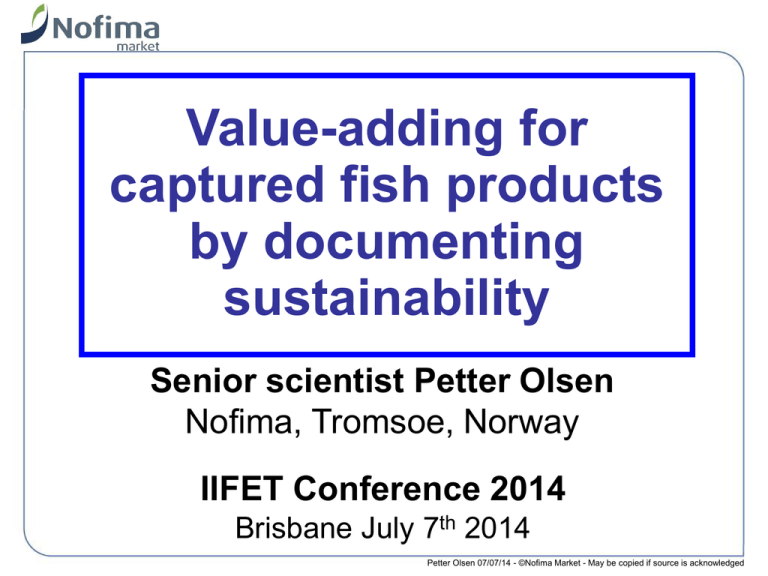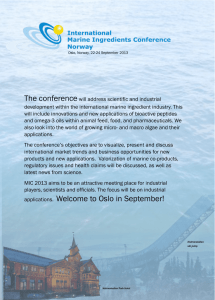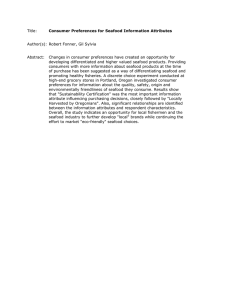Value-adding for captured fish products by documenting sustainability
advertisement

Value-adding for captured fish products by documenting sustainability Senior scientist Petter Olsen Nofima, Tromsoe, Norway IIFET Conference 2014 Brisbane July 7th 2014 Petter Olsen 07/07/14 - ©Nofima Market - May be copied if source is acknowledged About Nofima Nofima is a private, non-profit research institute owned by the Norwegian government with head office in Tromsø and over 400 employees in six different locations around Norway. Nofima was founded in 2008 when four former public food research institutes merged: • Norconserv – canned and preserved foods, Stavanger • Matforsk – food from agriculture, Ås • Akvaforsk – aquaculture related research, Sunndalsøra • Fiskeriforskning – seafood and processing, Tromsø Main areas of work: • Aquaculture and fisheries – raw materials • Food from agriculture and aquaculture – processes and products • Consumer and market research • - Consumer research, buying behaviour, food and context • Industrial economics and strategic management: • - Economics, corporate strategy • - Traceability, sustainability, environmental accounting Turnover in 2011 was 60 Million Euros Petter Olsen 07/07/14 - ©Nofima Market - May be copied if source is acknowledged This presentation 1. The NE Atlantic cod and haddock industry is facing increased competition, especially from imported farmed whitefish species 2. A portfolio of R&D projects was generated, where the objectives were all related to product value-adding 3. Examples of outputs from three such products, with focus on generic and reusable results, also relevant in other sectors 4. Conclusions on value-adding as a possible outcome of R&D projects Petter Olsen 07/07/14 - ©Nofima Market - May be copied if source is acknowledged Captured cod / haddock from the NE Atlantic Farmed tilapia / pangasius from Africa / Mekong • • • • Sold as frozen, but also fresh whitefish Direct competitors in the market Labels do not clearly differentiate Many consumers do not have a clear preference • Interchangeable in many seafood recipes • Large degree of mislabeling, especially of Atlantic cod (28% in US1) Petter Olsen 07/07/14 - ©Nofima Market - May be copied if source is acknowledged Captured cod / haddock from the NE Atlantic Farmed tilapia / pangasius from Africa / Mekong • Stock sustainability issues worldwide • NE Atlantic stocks sustainable2 • Despite this fact, on many “red lists” • Low negative environmental impact3 • High nutritional value4 • Regulative requirements • Environmental sustainability issues • Long transport distances (to Europe) • Social sustainability issues • Lower nutritional value4 • Few regulative requirements Petter Olsen 07/07/14 - ©Nofima Market - May be copied if source is acknowledged Production volume and price What to do? Decreasing price gap Petter Olsen 07/07/14 - ©Nofima Market - May be copied if source is acknowledged Need for R&D projects • Document sustainability of cod and haddock products from the NE Atlantic • Investigate consumer preferences, in particular in relation to desirable product characteristics • Make pilot implementation of consumerfacing communication of relevant product attributes • Develop tools, methods and standards to detect and reduce seafood product fraud and mislabelling Petter Olsen 07/07/14 - ©Nofima Market - May be copied if source is acknowledged P1 - EU project WhiteFish • 36 month duration, 01/2012 – 12/2014 • 2.9 MEUR total, 2 MEUR EU contribution • 13 participants from 5 countries WhiteFish objectives: • To strengthen the competiveness of the European cod and haddock industry by documenting and disseminating the relevant and desirable characteristics the products have, in particular in relation to sustainability, environmental impact and transparency. • Specifically, to develop a methodology called Batchbased Calculation of Sustainability Impact (BCSI) that SMEs can use for self-assessment and documentation. BCSI will be developed as a European standard supported by simple software tools. www.whitefishproject.org Petter Olsen 07/07/14 - ©Nofima Market - May be copied if source is acknowledged Environmental sustainability Vessel and gear data Catch data Petter Olsen 07/07/14 - ©Nofima Market - May be copied if source is acknowledged Social and economic sustainability Social impact categories Worker safety Companies salary levels Healthy working environment Employees’ job satisfaction Employees’ professional pride Community involvement of cod and haddock fishing companies Companies’ timely payment of salaries Pension fund contributions of companies for their employees Freedom of association and collective bargaining Employees’ working hours Economic impact categories Profitability per trip Production risk Obligat ory Recom mended X X X X X X X X X X Obligat Recom ory mended X X Petter Olsen 07/07/14 - ©Nofima Market - May be copied if source is acknowledged P2 - Nordic project WhiteFishMaLL • • • 36 month duration, 01/2012 – 12/2014 0.8 MEUR total, 0.6 MEUR Nordic contribution 9 participants from 4 countries WhiteFishMaLL objective: To build a branding platform for whitefish from the North Atlantic that differentiates in terms of outstanding quality, sustainable production and superior consumer benefits. It consists of: • Branding strategy (mission, attributes) • Industry guideline for how to collect, process and communicate relevant product information • Demonstration and evaluation of a specific innovative whitefish product www.whitefishmall.com Petter Olsen 07/07/14 - ©Nofima Market - May be copied if source is acknowledged Consumer communication Batch-specific labelling and product documentation Petter Olsen 07/07/14 - ©Nofima Market - May be copied if source is acknowledged Batchspecific From WhiteFishMaLL WEFTA poster5 Petter Olsen 07/07/14 - ©Nofima Market - May be copied if source is acknowledged P3 - EU project FoodIntegrity • • • 60 month duration, 01/2014 – 12/2018 11.5 MEUR total, 9 MEUR EU contribution 38 participants from 20 countries FoodIntegrity objectives: • To provide Europe with state of the art integrated capability for detecting fraud and assuring the integrity of the food chain • For seafood: To design, create and begin to populate a database suitable for documenting the degree and scope of seafood misdescription in Europe • For seafood: To do spot checks for selected products and analyse to what degree analytically verifiable claims about seafood products are true • For seafood: To develop a coherent and integrated toolbox, linking seafood product claims to analytical and paper-trail methods, to facilitate verification and validation www.foodintegrity.eu Petter Olsen 07/07/14 - ©Nofima Market - May be copied if source is acknowledged Seafood misdescription • Seafood is traded internationally more than any other foodstuff, most often seafood is processed and then traded • More than 1700 species of fish are traded internationally • For many species of fish, there is no internationally agreed upon commercial name, the same name is used in different countries to refer to completely different species • Seafood is a valuable commodity with great potential for differentiation between species and products • A particular challenge in the seafood industry is distinguishing between a seafood product that has farmed origin as opposed to wild caught origin • There is a great concern relating to sustainability of many fish stocks, a sustainability claim is valuable • Challenge in proving that the fish was legally caught and landed • Seafood is among top #3 misdescribed foodstuffs Petter Olsen 07/07/14 - ©Nofima Market - May be copied if source is acknowledged Anything useful come out of this? • Recommended set of indicators for companies who want to carry out their own sustainability assessment • European voluntary industry standard for selfassessment of sustainability impact: CEN Workshop Agreement (CWA) 76 - Batch-based Calculation of Sustainability Impact for Captured White Fish Products • WhiteFish self-assessment calculator freely distributed as interlinked spreadsheets • WhiteFishMaLL QR-code application to be commercialized • Seafood sampling and analysis report – prevalence of seafood fraud and misdescription in Europe • Seafood misdescription database – how, why, what species and products, what volume and value, etc. • Toolbox linking seafood claims to analytical and paper trail methods – given a seafood product property claim, how can it be verified? Petter Olsen 07/07/14 - ©Nofima Market - May be copied if source is acknowledged Conclusions on value-adding - 1 • This sort of value-adding is a bottom-up process. Companies must (already) be motivated and see the opportunities. • To go beyond individual already motivated companies and selfassessment is a large undertaking that must be industry driven if it is to succeed. • For motivated companies R&D and standardization initiatives of this type are very relevant. It provides them with a scientific basis for what they want to do, and it harmonises and reduces the work involved. Petter Olsen 07/07/14 - ©Nofima Market - May be copied if source is acknowledged Conclusions on value-adding - 2 • Self-assessment does not support intercompany benchmarking and it can only to a limited degree be used to substantiate consumer-facing claims. • The companies report that the competitive advantage is mainly gained through carrying out the self-assessment (and telling their customers about it); not through the results that come out of it. • Good data recording practice and traceability systems (both internal and external) is a prerequisite for companies who want to do this. Petter Olsen 07/07/14 - ©Nofima Market - May be copied if source is acknowledged Thank you for your attention Petter Olsen petter.olsen@nofima.no Selected references 1. 2. 3. 4. 5. The research leading to these results has received funding from the European Union's Seventh Framework Programme (FP7/2007-2013) under grant agreements n° 286141 – WhiteFish and n° 613688 – FoodIntegrity and from Nordic Innovation under grant 11087 – WhiteFishMaLL Oceana Study Reveals Seafood Fraud Nationwide, Oceana (2013). ICES Report of the Arctic Fisheries Working Group (2014). Winther, U., Ziegler, F., Skontorp Hognes, E., Emanuelsson, A., Sund, V., and H. Ellingsen (2009). Carbon footprint and energy use of Norwegian seafood products. SINTEF Fisheries and Aquaculture, International projects and consulting, Trondheim, Norway. Weaver et al (2008). The content of favorable and unfavorable polyunsaturated fatty acids found in commonly eaten fish. Journal of the American Dietetic Association, vol. 108, issue 7, pp 1178-1185. Gunnlaugsson, V., Viðarsson, J., Gregersen, O., Djurhuus, D., and Olsen, P. (2014). Product information at your fingertips. Poster at WEFTA 2014. Petter Olsen 07/07/14 - ©Nofima Market - May be copied if source is acknowledged





